Anubias is an inconsiderable in number genus of tropical aquatic (paludal) plants of Araceae family. What sets Anubias apart is its remarkable adaptability to various aquatic environments. These tropical plants thrive in both fully submerged and semi-submerged conditions. In their natural habitat, Anubias species predominantly grow in an emersed state, emerging above the water’s surface for most of the year. During the rainy season, however, they experience full submersion, demonstrating their resilience and versatility.
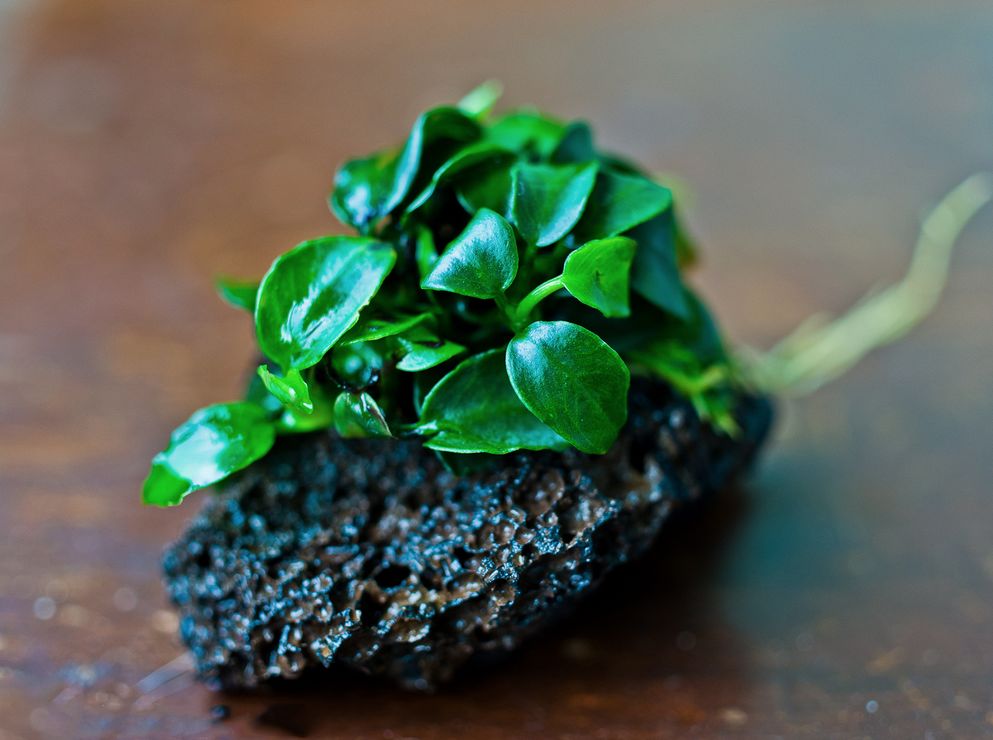
Contents
- 1 Habitat in the wild
- 2 Description
- 3 Difficulties in keeping
- 4 Care and keeping in a tank
- 5 Anubias types
- 5.1 Anubias afzelii or Anubias Congensis
- 5.2 Anubias Barteri Broad Leaf
- 5.3 Anubias barteri var. nana
- 5.4 Anubias nana petite
- 5.5 Anubias Nana Petite White
- 5.6 Anubias nana ‘Pinto’
- 5.7 Anubias Nana Golden
- 5.8 Anubias Nana Pangolino
- 5.9 Anubias Nana Bonsai
- 5.10 Anubias barteri var. ‘coffeefolia’
- 5.11 Anubias Minima
- 5.12 Anubias Glabra
- 5.13 Anubias gigantea
- 5.14 Anubias hastifolia
- 5.15 Anubias Nangi
Habitat in the wild
Anubias thrives in the tropical rainforests of Africa, particularly along the continent’s western coast, from Sierra Leone in the north to Angola in the south. These plants are typically coastal, growing along riverbanks, streams, and in bogs. While they can be fully submerged, they often grows with its leaves emerging above the water, a common trait among coastal plants.
This adaptability makes Anubias well-suited for both paludariums and aquariums. In paludarium conditions, where the plant is grown emersed, plant tends to grow faster, develop larger leaves, and bloom more frequently, increasing the likelihood of seed production. Additionally, this environment helps prevent algae fouling, which is a significant advantage.
Description
These are plurannual plants with low growth pace. They have a thick trailing rootstalk (called rhizome). The leaves grow upwards from rhizome and the roots – downwards, correspondingly. Root system of species is built so, that thin roots always take rhizome up above the substrate, which looks like if the plant was standing on some curved legs.
This is rhizome, that is often mistaken for a trailing stem, which Anubias uses to stick to the substrate. There is a growing point at the end of rhizome, where new leaves of the plant appear. It gets a bit elongated with each new leaf and in time it can become several dozens of centimeters long.
When planting it is not recommended to bury its rootstalk into the substrate, it’s better to put it above the latter or to fixate it somehow to snags or other tank decorations.
If when planting species you bury it too deep, it may start to rot. The rootstalk should be above the substrate surface, just the roots growing from it should be buried a bit.
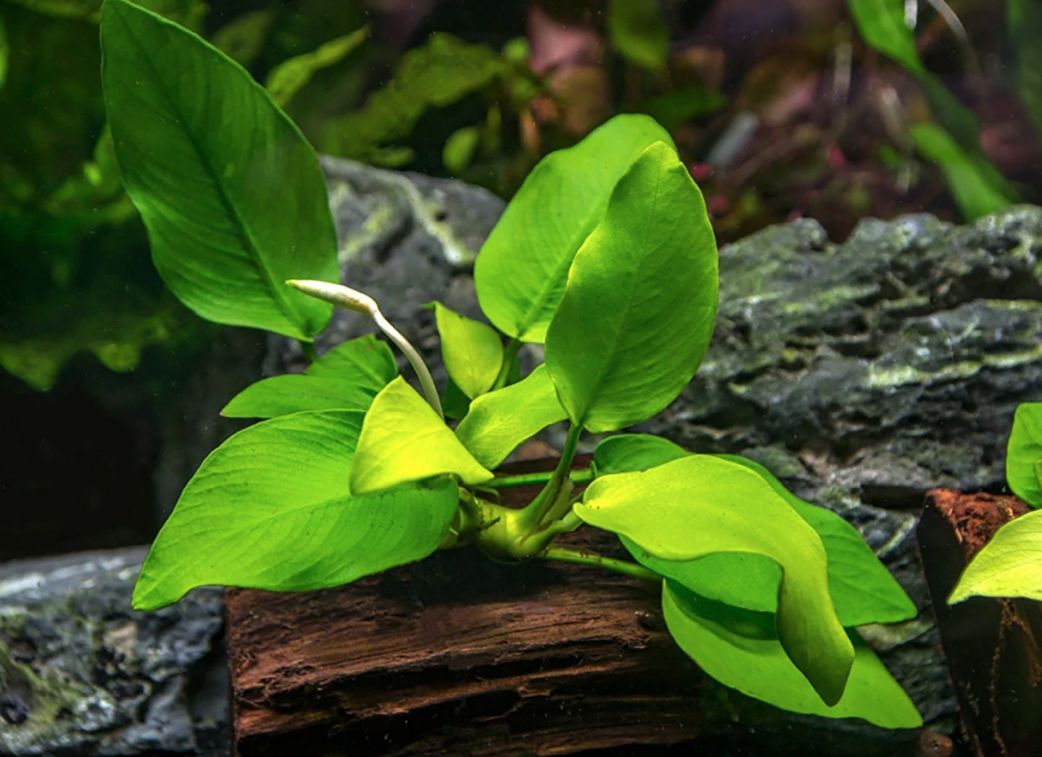
Leaves of the plant are coarse and leathery, that’s why all species are good for tanks with large cichlids (like a flowerhorn) and herbivorous fish species.
Despite relatively small number of species, Anubias impress with their diversity; partially due to the fact, that recently a lot of hybrids of the plant have appeared.
The plants are good looking, exotic, but they aren’t classified. Because of this there is a classification mess both on the market and in amateur aquariums. One and the same plant is sold labeled with different names.
Lamina of various species may vary essentially and have different shapes: leaves can be round-, heart-, halberd-, oval- and arrow shaped or almost triangular and elongated to some extent.
Plants are suitable for paludariums and greenhouses at high humidity and there they grow better than in aquariums. Moreover, this is paludarium where the plants grow to reach their maximal size, they bloom and don’t suffer from algae fouling. Besides, some species require regular period of rest after growing in their submerged form.
Anubias has small hermaphrodite flowers, their coloring varies from pale rose to chestnut, they are gathered in a thick spadix inside enveloped, usually pale green spathe. The plants usually bloom when they are out of water, but some of them can do it under water as well.
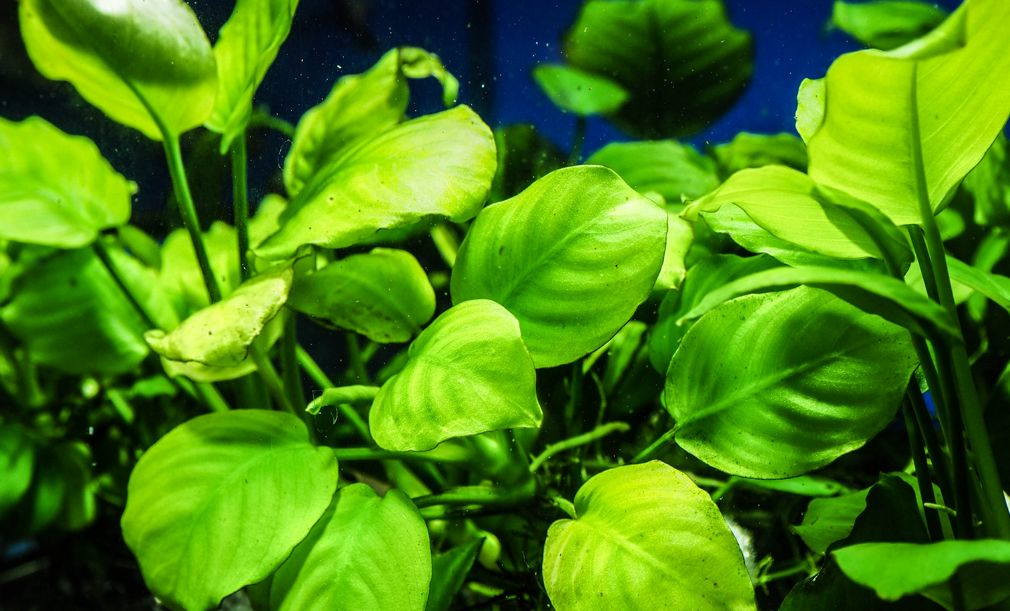
Difficulties in keeping
Anubias species can be considered as one of the most undemanding tank plants. They perfectly strike roots both in a substrate of a newly run tank poor with nutrients and in the old one with lots of nutrients.
Together with cryptocorynes, these plants can survive even in neglected souring substrate, where other plants usually die. On the other hand, all species have exclusive ornamental properties and diversity of kinds. You can decorate a tank with them by not only planting into the substrate, but attaching them to snags and stones as well.
Due to relatively slow growth rate, bush can maintain its shape for several years, while its unpretentiousness to growing conditions and resistance to various illnesses allow to decrease the amount of time and efforts to take care about it.
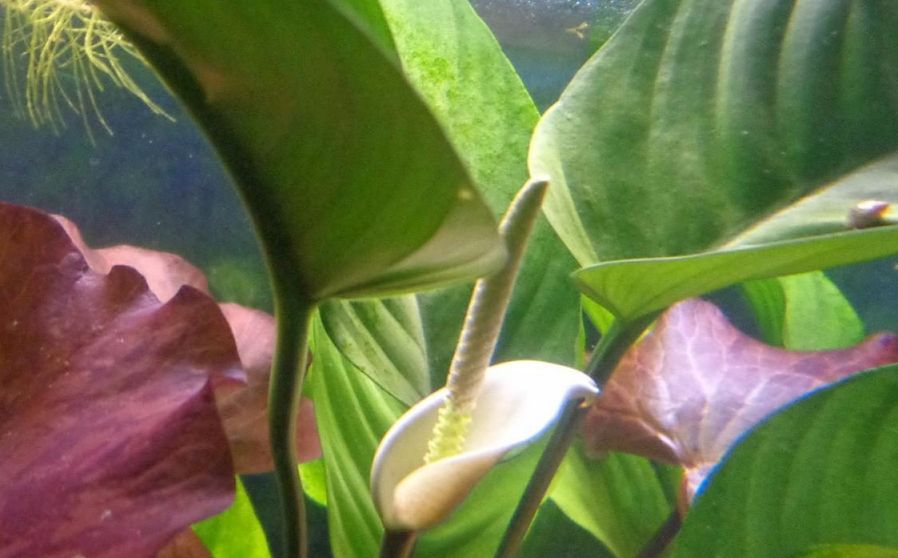
Care and keeping in a tank
Anubias is a thermophilic plant, thriving best in temperatures ranging from 24 to 28°C. During its rest period, the temperature can drop to 18-20°C. While plants can tolerate brief exposure to lower temperatures, prolonged cold conditions can cause it to shed its leaves.
Lighting: prefers low to moderate light. Excessive illumination can overwhelm the plant’s slow photosynthesis cycle, leading to algae growth on its leaves. For optimal results, provide scattered lighting by creating shadows with floating plants on the water surface. Aim for a light duration of 11-12 hours per day.
Water Conditions: grows well in clean, transparent water with a total hardness of 6 to 40° and a pH range of 6.0 to 7.5. Regular water changes are crucial to prevent algae fouling, as Anubias is sensitive to excessive organic buildup. In polluted conditions, the plant’s old leaves may die off quickly, leaving only a few young leaves or potentially leading to plant death.
Substrate: Use a nutrient-rich substrate, as the roots of some species can penetrate deeply. A suitable mix for paludariums includes sand, clay, peat, and humus.
Care Tips: If Anubias is grown underwater continuously, some species may experience slow degradation, with smaller leaves and reduced growth. To counteract this, periodically transition the plants to paludarium conditions—either semi-emersed or in high humidity without water. This helps rejuvenate the plant and prevent issues like algae infestation and leaf rot.
Anubias types
Anubias afzelii or Anubias Congensis
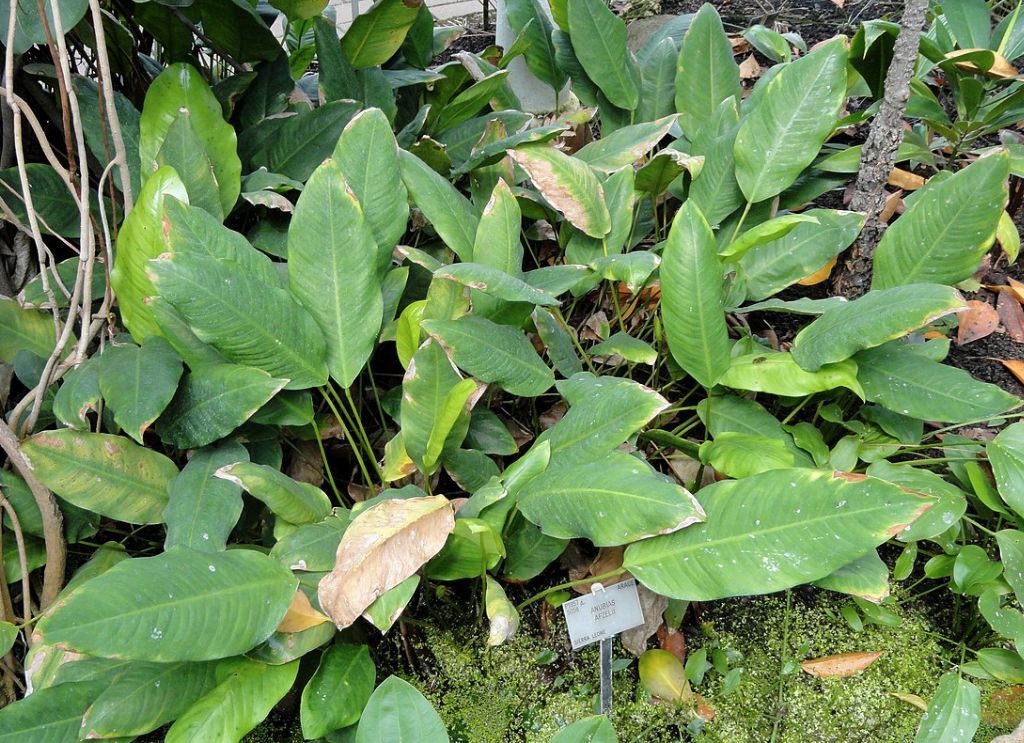
Anubias afzelii (ex. Anubias Congensis) is a species plant characterized by its broad, heart-shaped leaves and sturdy rhizome, known for its resilience and suitability for both aquariums and terrariums.
This species has high ornamental properties, but at the same time it needs care and keeping conditions very different from those required by others. It has a shortened rhizome, that’s why the plant appearance more resembles cryptocorynes and Echinodorus.
Its leaves are lanceolate, sharpened and elongated. The rhizome of the plant develops under ground, so the plant should be buried deep enough when being planted.
It has low growth pace, usually not more than 1-2 new leaves appear in a month. Scattered light is required to make sure that the plant leaves won’t get covered with algae. Proper filtration and regular water renew are good for the plant, otherwise you may observe Anubias shedding off its old leaves. It is desirable to provide the plant with a silted substrate.
Optimal tank water temperature is 72–82 °F (22–28 °C).
Once a year or 1.5 years it is good to give the plant some rest by replanting it and putting for several months from a tank to a humid greenhouse or paludarium, where the plant feels much better and grows faster as well.
It is better to cultivate this species in a greenhouse as well. First the plant shoots are grown out of water and only when they have 5-6 well developed leaves they are planted into a tank. A. afzelii care requires some specific skills and experience from the aquarist, that’s why for beginners it is better to choose some other species.
| Scientific Name | Anubias afzelii |
| Family | Araceae |
| Native To | West Africa |
| Lighting Needs | Low to Moderate |
| Growth Form | Rhizome |
| Growth rate | Slow |
| Temperature Required | 72–82 °F (22–28 °C) |
| pH Level | 6.0-7.5 |
| Care Level | Easy |
| Placement in Tank | Mid to Background, depending on tank size |
| Maximum plant size | up to 35 cm long and 13 cm wide |
Anubias Barteri Broad Leaf
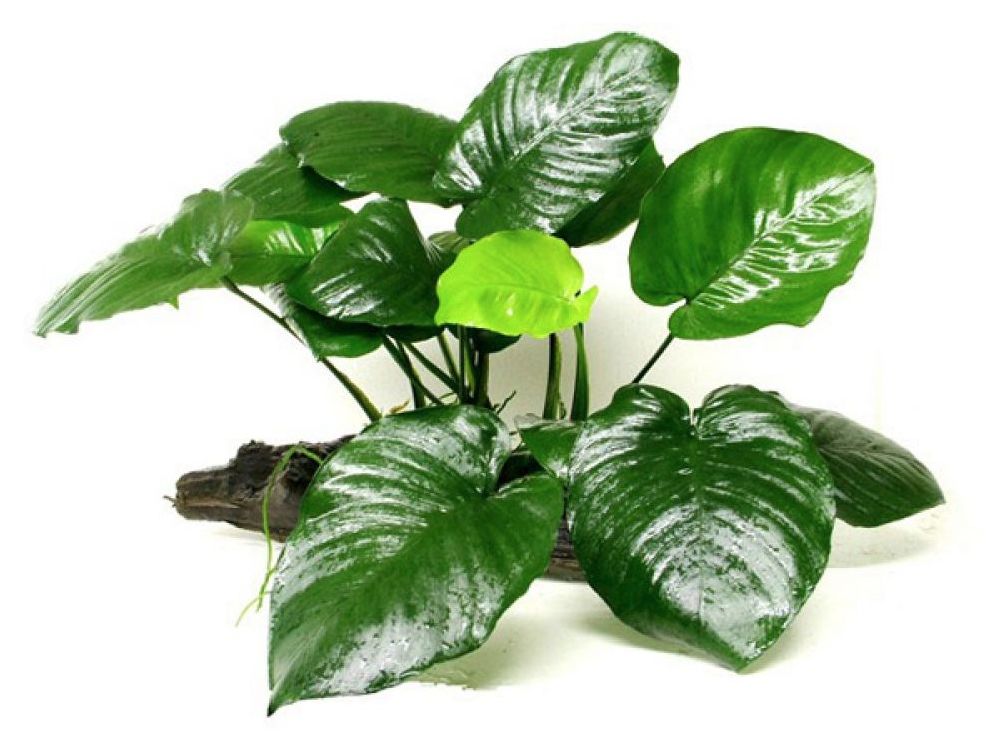
It is a popular aquatic plant among aquarium enthusiasts. It belongs to the family Araceae and is native to the tropical regions of West Africa, specifically Nigeria, Cameroon, and Gabon. Broad Leaf has large, broad, and elongated leaves that grow in a rosette pattern. The leaves are dark green and leathery, with prominent veins running through them. The plant can grow up to 16 inches (40 cm) tall.
Broad Leaf is adaptable to a wide range of water parameters. It thrives in temperatures between 72-82°F (22-28°C) and prefers slightly acidic to neutral water with a pH range of 6.0-7.5. It can tolerate a moderate range of hardness levels.
| Characteristic | Description |
|---|---|
| Scientific Name | Anubias barteri var. barteri |
| Common Name | Anubias Barteri Broad Leaf |
| Family | Araceae |
| Native to | West Africa (Nigeria, Cameroon, Gabon) |
| Growth Rate | Slow |
| Leaf Shape | Large, broad, elongated leaves |
| Leaf Color | Dark green |
| Leaf Texture | Leathery with prominent veins |
| Maximum Height | Up to 16 inches (40 cm) |
| Lighting Requirements | Low to moderate |
| Preferred Water Parameters | Temperature: 72-82°F (22-28°C) |
| pH: 6.0-7.5 | |
| Hardness: Moderate | |
| Propagation | Rhizome |
| Placement | Can be attached to driftwood, rocks, or other aquarium decorations |
| Care Level | Easy |
Anubias barteri var. nana
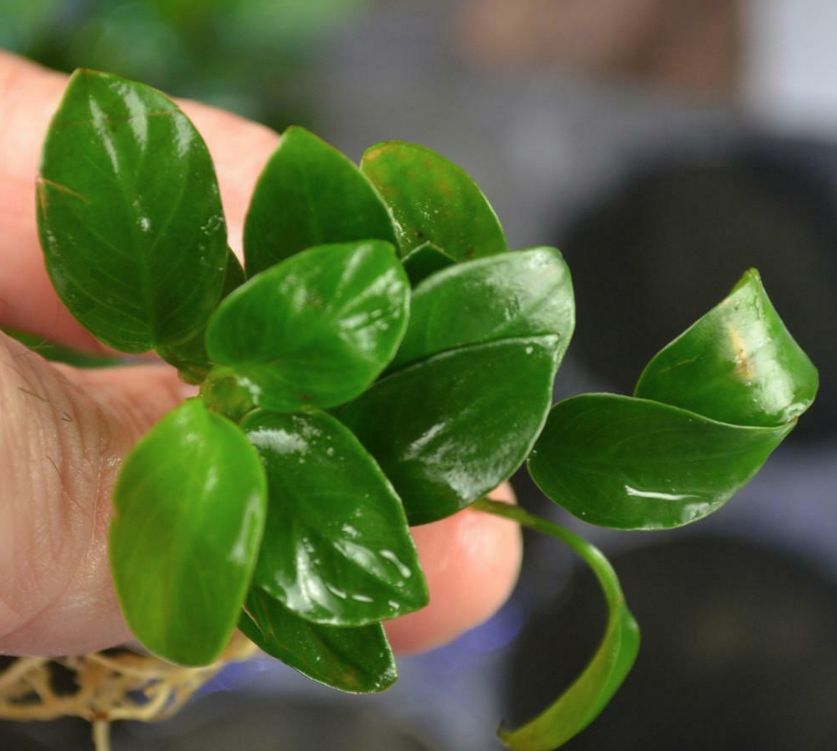
It is one of the most slow-growing tank plants and one of the most widespread among all species. It has become popular due to its small size.
Classical barteri is rather large sized species, which grows up to 30 cm tall and at that its lamina diameter is up to 10 cm. These characteristics make the plant perfect for large tanks, especially with fishes that don’t get on well with most of aquarium plants. Anubias nana size as a rule doesn’t exceed 10 cm, more often it is about 3-4 cm high.
This species is distinguished by its variability and in tanks quite often you may see barteri petite – its most unpretentiousness and small leaved kind.
All varieties of the plant prefer tropical tanks with water temperature about 24-26 °C. Water hardness and acidity aren’t crucial for the plant. You can grow it both in a substrate and on snags.
| Scientific Name | Anubias barteri var. nana |
| Genus | Anubias |
| Family | Araceae |
| Common names | Anubias Nana; Dwarf anubias; anubias petite |
| Plant Type | Rhizomatous |
| Lighting Needs | Low to Moderate |
| Growth rate | Slow |
| CO2 | Not required, but beneficial |
| Temperature Required | 22-28 °C (72-82 °F) |
| pH Level | 6.0-7.5 |
| KH | 3-10 |
| Care Level | Easy |
| Minimum tank size | 10 gallons |
| Maximum plant size | Up to 4 inches (10 cm) |
Anubias nana petite
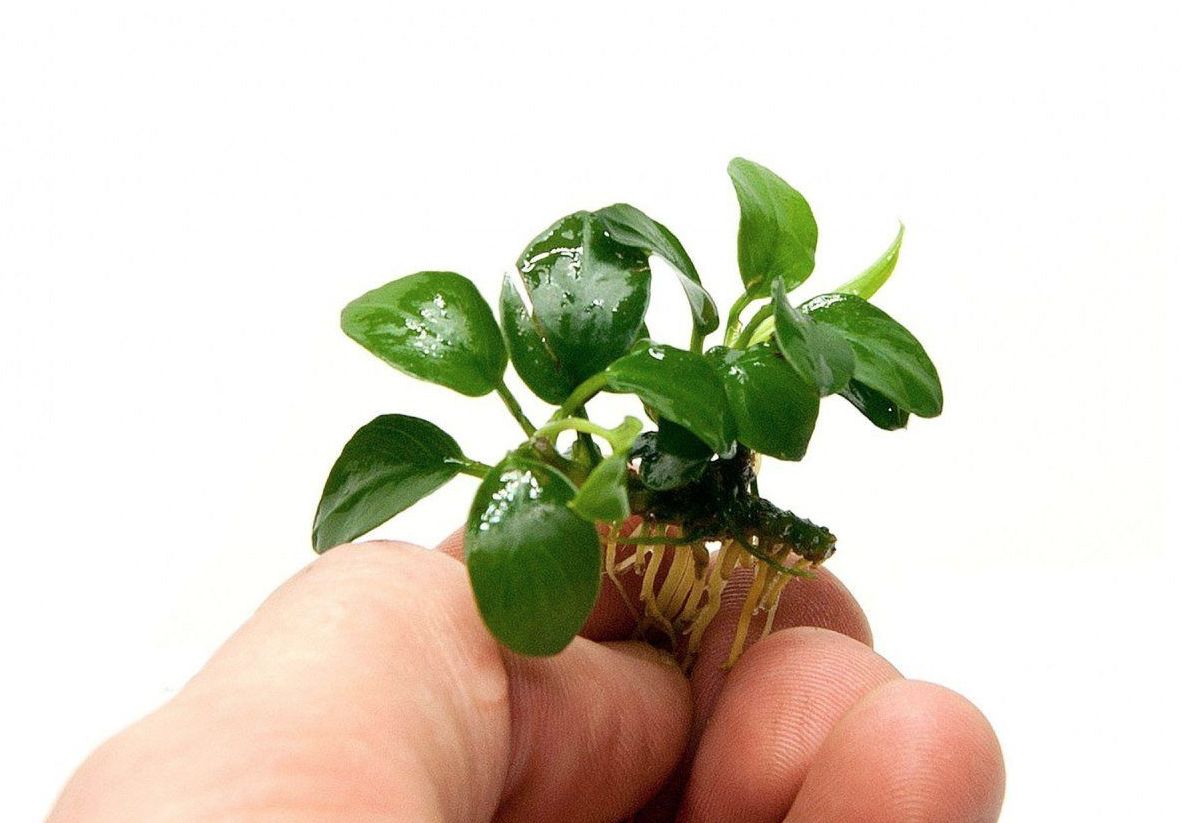
We devoted a separate article to Anubias nana. It is even smaller than Anubias nana. The size of its leave doesn’t exceed 1 inch (2.5 cm). It demonstrates the best appearance when attached to a snag or stone. In tanks it forms short thick vegetation and that’s why it is usually put in the foreground of a tank. The plant shows its best ornamental properties when put on stones or snags.
| Characteristic | Description |
|---|---|
| Plant Size | Small and compact, typically reaching heights of 2 inches (5 cm). |
| Leaf Size | Leaves are relatively small, around 0.5-1 inch (1-2.5 cm) in length. |
| Leaf Color | Dark green with glossy texture. |
| Leaf Shape | Broad, heart-shaped leaves with pointed tips. |
| Growth Rate | Slow growth rate compared to other Anubias varieties. |
| Rhizome | Thick, creeping rhizome from which leaves emerge. |
| Lighting | Can thrive in low to moderate lighting conditions. |
| CO2 Requirement | CO2 supplementation is not required but can benefit growth. |
| Water Parameters | Prefers slightly acidic to neutral water (pH 6.0-7.5) and moderate water hardness (2-15 dKH). |
| Placement | Ideal for midground or foreground placement in aquariums or as a highlight in terrarium setups. |
| Compatibility | Compatible with a variety of tank mates and suitable for both beginner and experienced aquarists. |
Anubias Nana Petite White
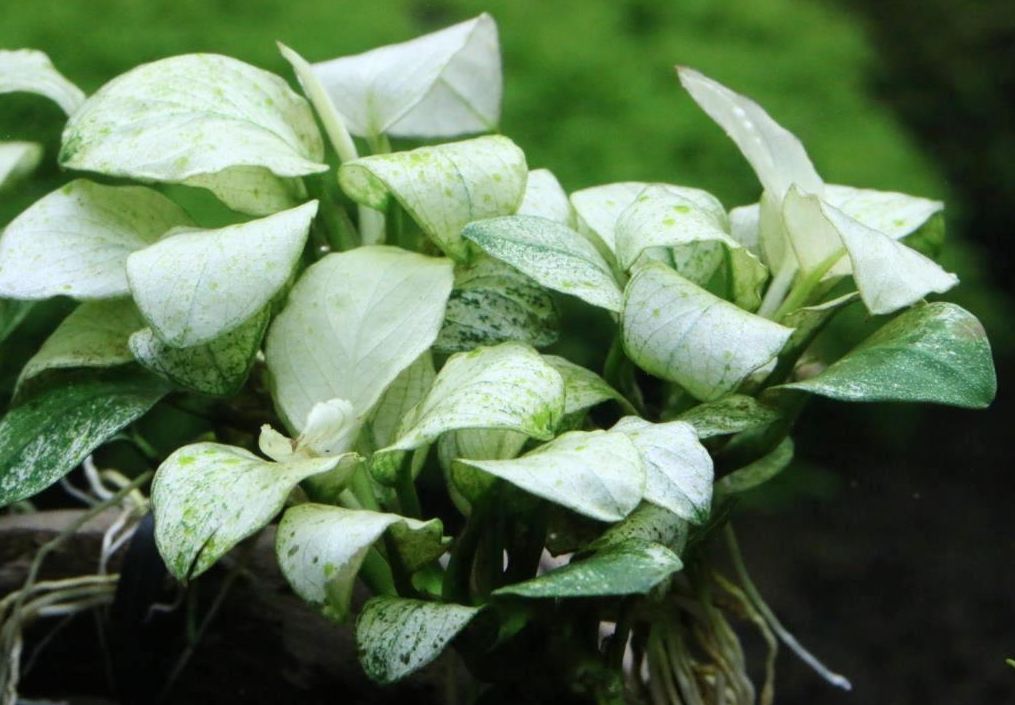
It is an rare variant of Anubias Nana Petite. The spectacular white coloration is an uncommon result of a mutation that has occurred, causing the plant to have little to no chlorophyll in its leaves.
Anubias nana ‘Pinto’
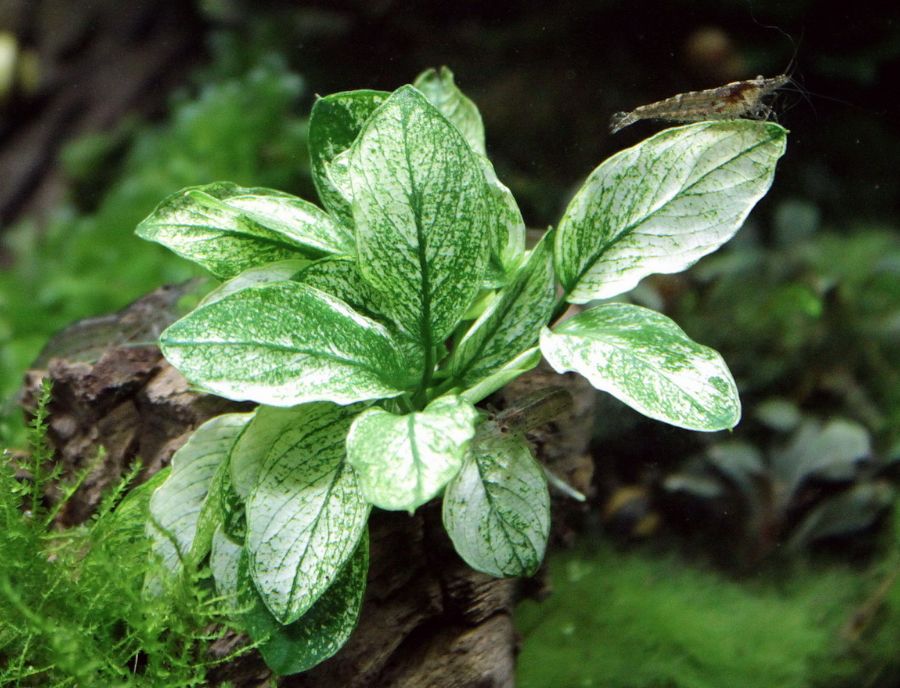
Anubias nana ‘Pinto’ is a captivating variation, featuring striking white or cream-colored variegation on its leaves, creating a visually striking contrast against the deep green background, making it a sought-after choice for aquascaping enthusiasts.
| Characteristic | Description |
|---|---|
| Plant Size | Compact, typically grows up to 5-10 cm (2-4 inches) in height |
| Leaf Color | Variegated, with shades of green, cream and white |
| Leaf Shape | Heart-shaped or lanceolate |
| Growth Rate | Slow |
| Light Requirements | Moderate to low light intensity |
| CO2 Requirements | Low |
| Water Parameters | pH 6.0-7.5, temperature 22-28°C (72-82°F) |
| Placement in Aquarium | Foreground or midground, can be attached to rocks or driftwood |
| Difficulty Level | Easy |
Anubias Nana Golden
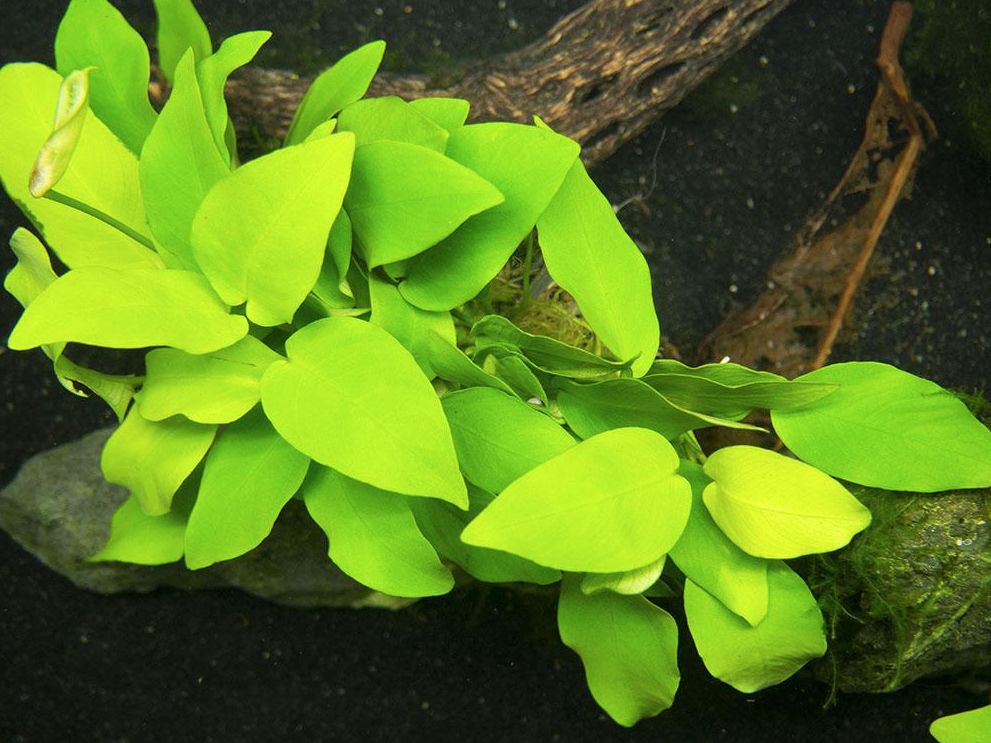
It is a captivating and visually striking aquatic plant. It is a popular variety of Anubias known for its vibrant golden or yellowish-green leaves. This plant features small to medium-sized heart-shaped leaves with pointed tips. The leaves are relatively thick and have a glossy texture, adding to their appeal.
| Characteristic | Description |
|---|---|
| Plant Size | Small and compact, typically reaching heights of 3-5 inches (7,5-12 cm). |
| Leaf Size | Leaves are relatively small, around 1-2 inches (2.5-5 cm) in length. |
| Leaf Color | Vibrant golden or yellowish-green coloration, adding a unique and striking visual appeal. |
| Leaf Shape | Broad, heart-shaped leaves with pointed tips, similar to other Anubias Nana varieties. |
| Growth Rate | Slow growth rate compared to other Anubias species, maintaining a compact size over time. |
| Rhizome | Thick, creeping rhizome from which leaves emerge. |
| Lighting | Can thrive in low to moderate lighting conditions, but higher lighting may enhance color intensity. |
| CO2 Requirement | CO2 supplementation is not required, but it can promote faster and healthier growth. |
| Water Parameters | Prefers slightly acidic to neutral water (pH 6.0-7.5) and moderate water hardness (2-15 dKH). |
| Placement | Ideal for midground or foreground placement in aquariums, providing a bright focal point in aquascapes. |
| Compatibility | Compatible with a variety of tank mates, making it suitable for community tanks. |
Anubias Nana Pangolino
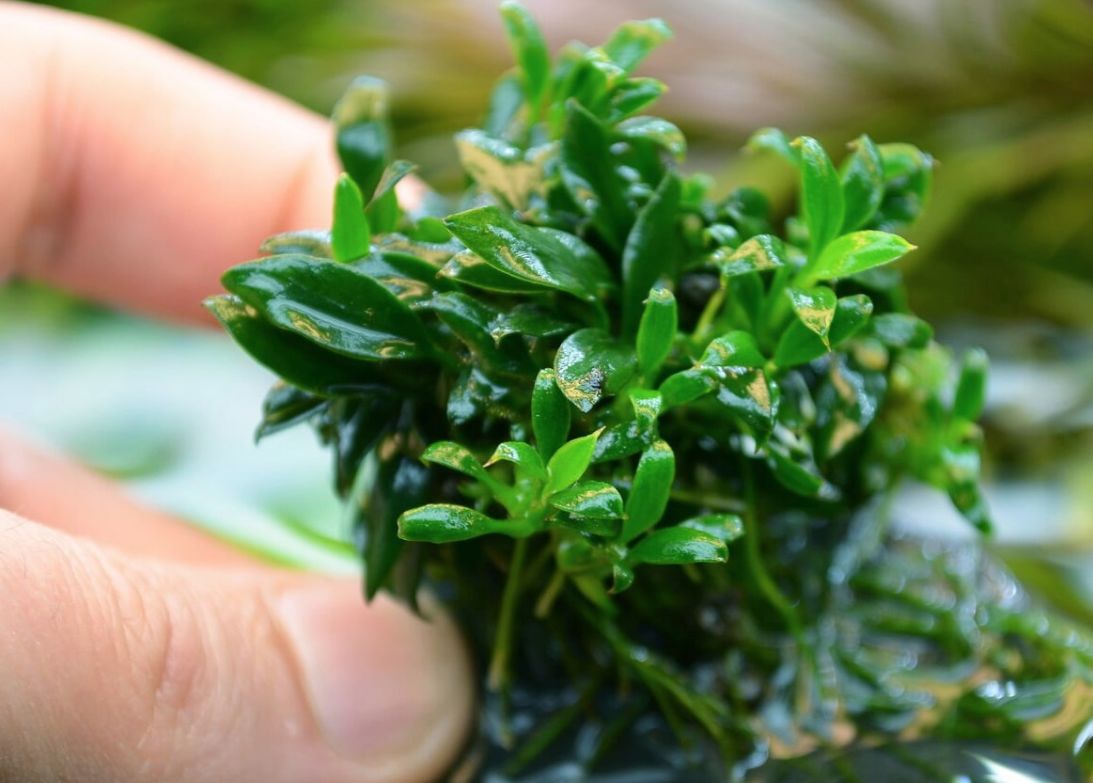
Anubias Pangolino is a rare variant of Anubias thats highly sought after due to its tiny leaves. This plant is smaller than Anubias Nana Petite. It’s a very slow growing plant that’s named after the scales of a Pangolin.
| Characteristic | Description |
|---|---|
| Plant Size | Tiny and compact, typically reaching heights of 3 cm. |
| Leaf Size | Leaves are relatively small, around 0,5 cm in length. |
| Leaf Color | Green |
| Leaf Shape | Heart-shaped leaves with pointed tips, similar to other Anubias Nana varieties. |
| Growth Rate | Slow growth rate compared to other Anubias species, maintaining a compact size over time. |
| Rhizome | Thick, creeping rhizome from which leaves emerge. |
| Lighting | Can thrive in low to moderate lighting conditions, but higher lighting may enhance color intensity. |
| CO2 Requirement | CO2 supplementation is not required, but it can promote faster and healthier growth. |
| Water Parameters | Prefers slightly acidic to neutral water (pH 5.0-8.5) and moderate water hardness (2-15 dKH). |
| Placement | Ideal for foreground placement in aquariums, providing a bright focal point in aquascapes. |
| Compatibility | Compatible with a variety of tank mates, making it suitable for community tanks. |
Anubias Nana Bonsai
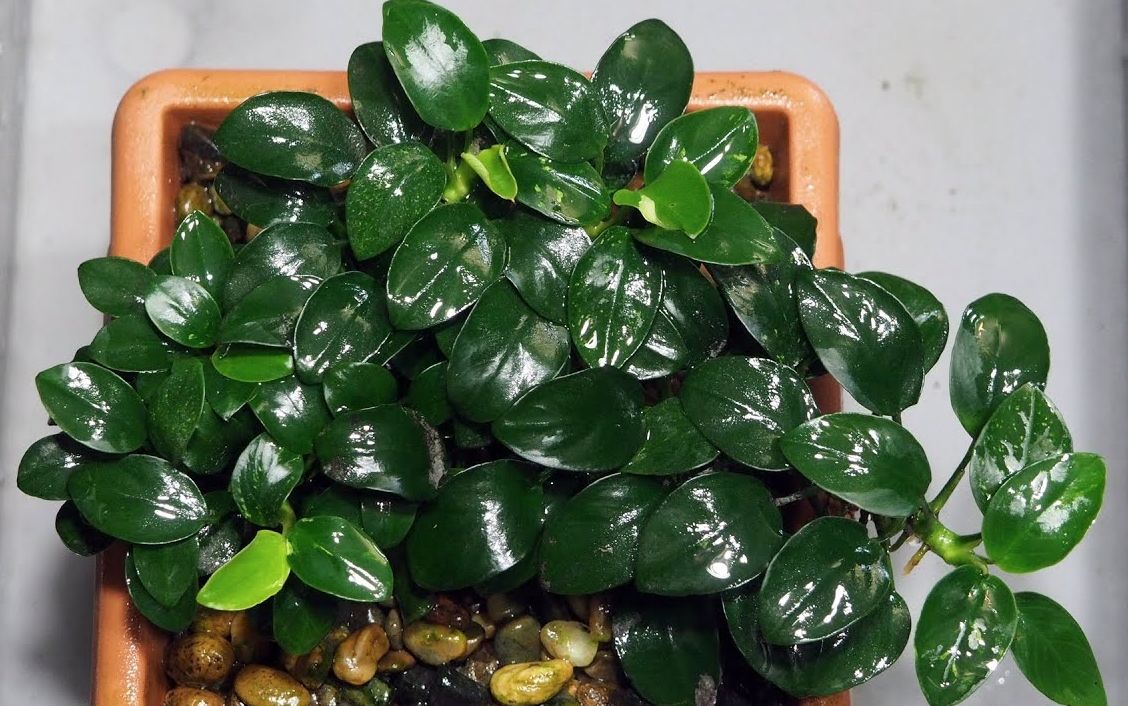
It is a unique and visually appealing variety of the popular plant. It is characterized by its small size, compact growth, and bonsai-like appearance, which adds an interesting and artistic element to aquariums.
The leaves of Anubias Nana ‘Bonsai’ are typically dark green and have a thick texture. They are relatively short, ranging from 1-2 inches (2.5-5 cm) in length, and have a pointed tip. The shape of the leaves can vary, but they are usually heart-shaped or lanceolate in form. The overall leaf structure contributes to the bonsai-like aesthetic of this plant.
Unlike other Anubias varieties that can grow quite large, Anubias Nana ‘Bonsai’ remains compact and maintains a manageable size, typically reaching a height of 2 inches (5 cm). This makes it an excellent choice for smaller aquariums, nano tanks, or for creating intricate foreground layouts.
| Characteristic | Description |
|---|---|
| Plant Size | Small and compact, typically reaching heights of 2 inches (5 cm). |
| Leaf Size | Leaves are relatively short, ranging from 1-2 inches (2.5-5 cm) in length. |
| Leaf Color | Dark green leaves, adding a natural and lush appearance to the aquarium. |
| Leaf Shape | Heart-shaped or lanceolate leaves with a pointed tip, contributing to the bonsai-like appearance. |
| Growth Rate | Slow growth rate, maintaining a compact size and requiring less frequent trimming. |
| Rhizome | Thick, horizontal rhizome from which leaves emerge; should be attached to hardscape or left exposed. |
| Lighting | Can thrive in a wide range of lighting conditions, from low to moderate intensity. |
| CO2 Requirement | CO2 supplementation is not required, but it can promote faster growth and healthier appearance. |
| Water Parameters | Prefers slightly acidic to neutral water (pH 6.0-7.5) and moderate water hardness (2-15 dKH). |
| Placement | Ideal for foreground placement in aquariums or for creating intricate bonsai-like layouts. |
| Compatibility | Compatible with a variety of tank mates and suitable for both beginner and experienced aquarists. |
Anubias barteri var. ‘coffeefolia’
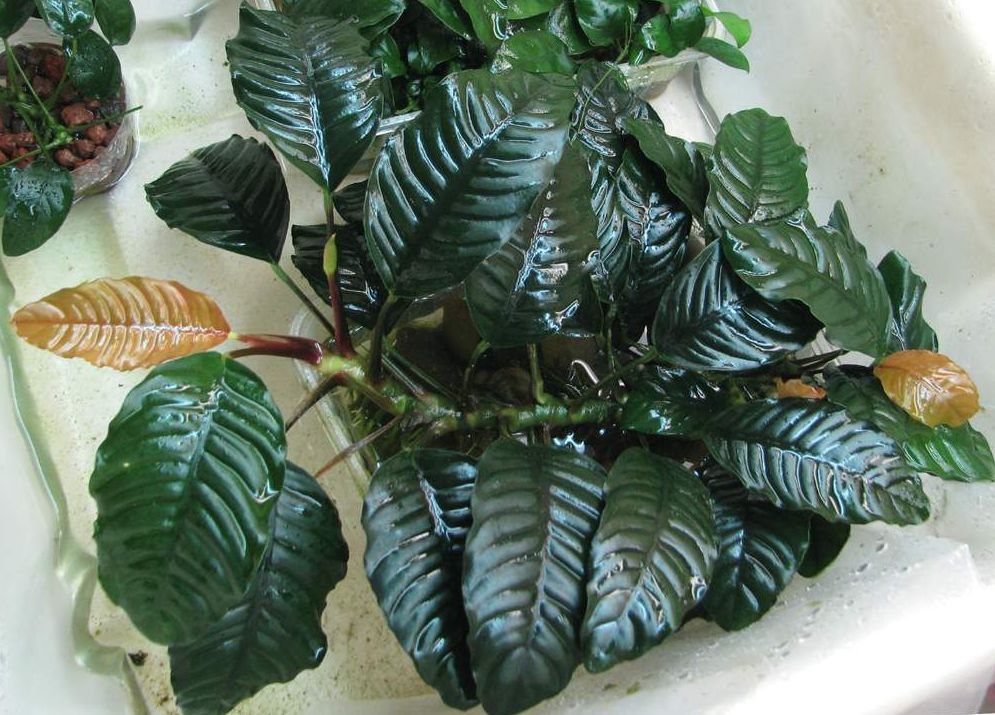
Anubias barteri “Coffeefolia” got its name due to the unusual shape of its leaves, which resembles that of a coffee tree. The plant leaves are a bit wavy, more coarse, than that of the basic plant kind and they grow on a short reddish footstalks.
The plant grows a bit slower of nominative A. barteri, it is more prone to algae fouling appearance and unlike the latter it requires several moths of rest in a warm greenhouse once in a year or two.
| Scientific Name | Anubias barteri var. ‘coffeefolia’ |
| Family | Araceae |
| Native To | West Africa |
| Lighting Needs | Low to Moderate |
| Growth Form | Spreading rhizome |
| Growth rate | Slow |
| Temperature Required | 72° – 80° F (22° – 27° C) |
| pH Level | 5.5 – 9.0 |
| Care Level | Medium |
| Placement in Tank | Midground |
| Maximum plant size | 15 inches for most species |
Anubias Minima
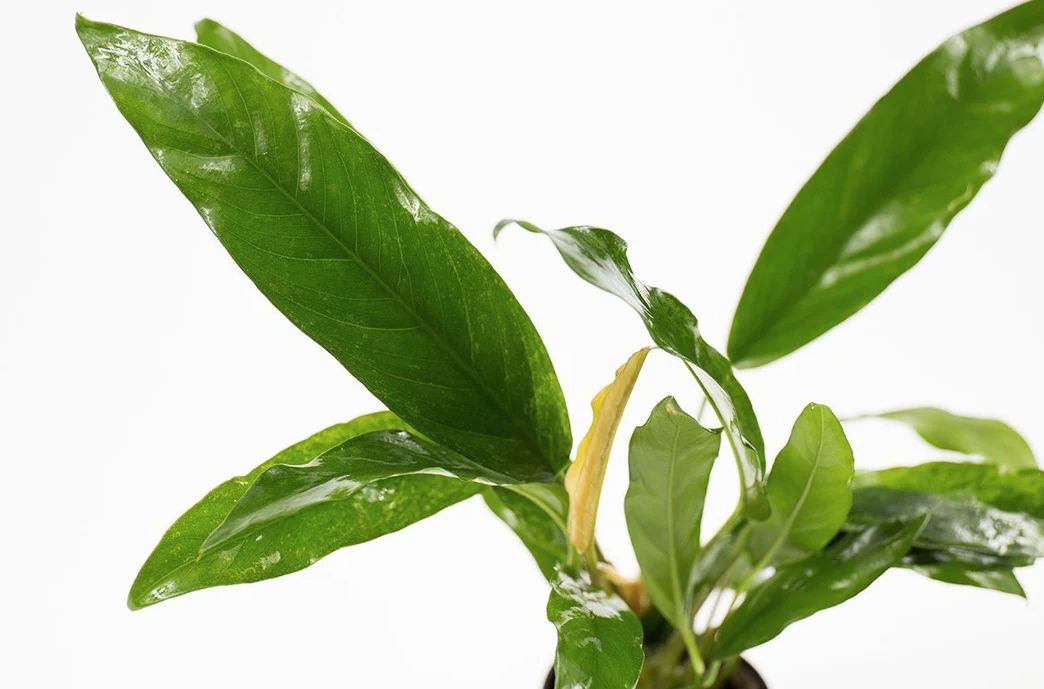
Anubias minima is characterized by its small, narrow leaves. The leaves are typically lanceolate or elliptical in shape and have a dark green coloration. The plant remains relatively compact, with a height of around 6-8 inches (15-20 cm).
| Characteristic | Description |
|---|---|
| Scientific Name | Anubias minima |
| Family | Araceae |
| Growth Rate | Slow |
| Leaf Shape | Narrow, lanceolate or elliptical leaves |
| Leaf Color | Dark green |
| Maximum Height | Around 6-8 inches (15-20 cm) |
| Lighting Requirements | Low to moderate |
| Preferred Water Parameters | Temperature: 72-82°F (22-28°C) |
| pH: 6.0-7.5 | |
| Hardness: Moderate | |
| Care Level | Easy |
Anubias Glabra
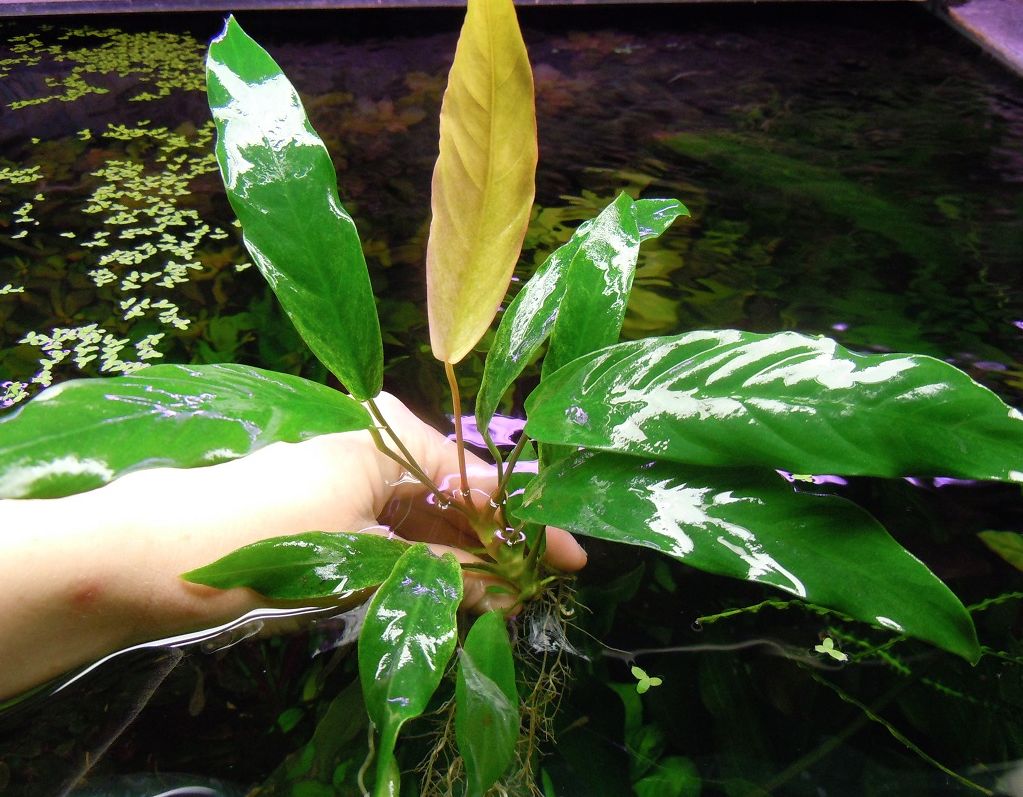
Anubias Glabra is characterized by its thick, dark green leaves that are heart-shaped or lanceolate in form. The leaves have a glossy texture and can grow to lengths of around 15 – 25 cm. The plant has a compact and bushy growth habit.
| Characteristic | Description |
|---|---|
| Leaf Shape | Heart-shaped or lanceolate leaves with a glossy texture. |
| Leaf Size | Leaves can grow to lengths of around 4-6 inches (10-15 cm). |
| Leaf Color | Dark green leaves, adding a vibrant and lush appearance to the aquarium. |
| Growth Rate | Slow to moderate growth rate, making it easier to maintain and control. |
| Plant Size | Medium-sized species, reaching heights of 6-10 inches (15-25 cm) when fully grown. |
| Rhizome | Thick, horizontal rhizome from which leaves emerge; should be attached to hardscape or left exposed. |
| Lighting | Adaptable to a wide range of lighting conditions, from low to moderate intensity. |
| CO2 Requirement | CO2 supplementation is not required, but it can promote faster growth and healthier appearance. |
| Water Parameters | Prefers slightly acidic to slightly alkaline water (pH 6.0-7.5) and moderate water hardness (2-15 dKH). |
| Placement | Suitable for midground or background placement in aquariums. |
| Compatibility | Compatible with various tank mates, including fish and shrimp, and suitable for freshwater setups. |
Anubias gigantea
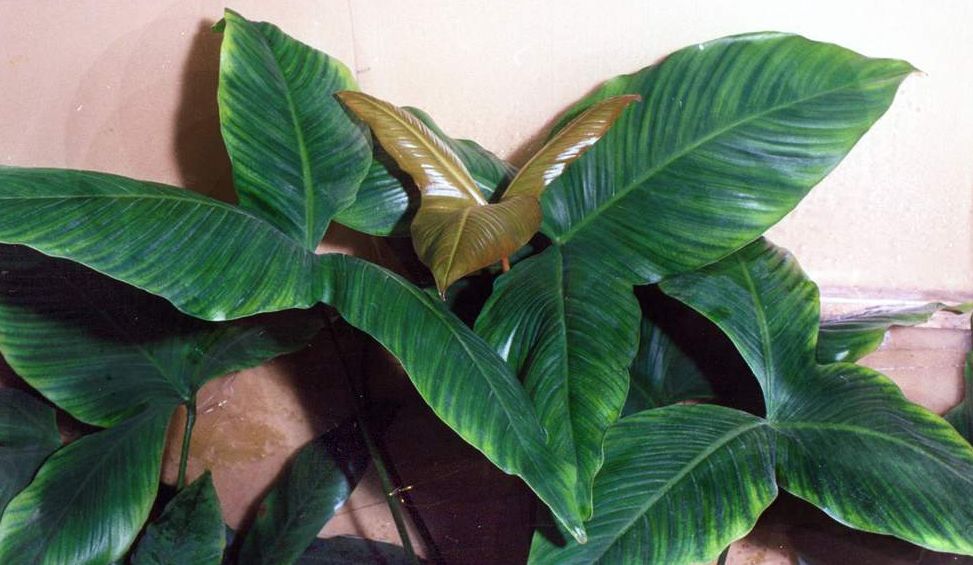
As you may guess from the name, this species has a large size. This is the largest Anubias you may encounter in amateurs tanks. It forms a huge bush, where you can count up to 30 leaves about 80-100 cm tall.
To keep such an Anubias you will need a tank not less than half of a ton capacity. It grows the same slowly as other representatives of the kind: about 2-4 new leaves appear in a year.
Emerged form of the plant, grown in paludarium poorly adapts to abrupt complete submerging, that’s why it requires gradual transformation from its emersed form to submerged one.
When planting this species its rootstalk should remain above the substrate surface. It is put into the substrate so, that the trailing rootstalk remains several centimeters above the substrate and only its roots growing downwards are inside the substrate.
Provided with proper conditions it can bloom by shooting a long, about 50 cm flower-bearing stem.
| Scientific Name | Anubias gigantea |
| Family | Araceae |
| Native To | Africa |
| Lighting Needs | Low to Moderate |
| Growth Form | Rhizome |
| Growth rate | Slow |
| Temperature Required | 72-82 °F |
| pH Level | 6.0-7.5 |
| Care Level | Easy |
| Placement in Tank | Background |
| Maximum plant size | leaves up to 30 cm (12 in) long and 14 cm (6 in) wide |
Anubias hastifolia

It is one of the largest aquarium Anubias species. Anubias hastifolia is characterized by its large, arrowhead-shaped leaves. The leaves are relatively thick and have a dark green coloration. The plant can grow up to 16 inches (40 cm) in height.
The plant is enduring and relatively undemanding. It requires regular iron containing fertilization to ensure its optimal growth rate. It can’t stand bright light, therefore it requires some shadowed areas to grow.
It is better to plant it in shadow to limit growth of algae fouling on its leaves. This is an enduring plant, though it finds it hard to adapt to submerged way of growing in a tank and it grows very slowly under water.
However, it is worth recommending for aquarists to grow it in large paludariums. The plant has very coarse leaves and most of herbivorous fishes don’t eat them, that’s why it can be a good choice for a tank with African cichlids or goldfish species.
| Scientific Name | Anubias hastifolia |
| Family | Araceae |
| Native To | West Africa |
| Lighting Needs | Low to Moderate |
| Growth Form | Rhizome |
| Growth rate | Slow |
| Temperature Required | 68 – 86 °F (20-30 °C) |
| pH Level | 5.5 – 9.0 |
| Care Level | Medium |
| Placement in Tank | Background |
| Maximum plant size | leaves up to 40 cm long and more |
Anubias Nangi
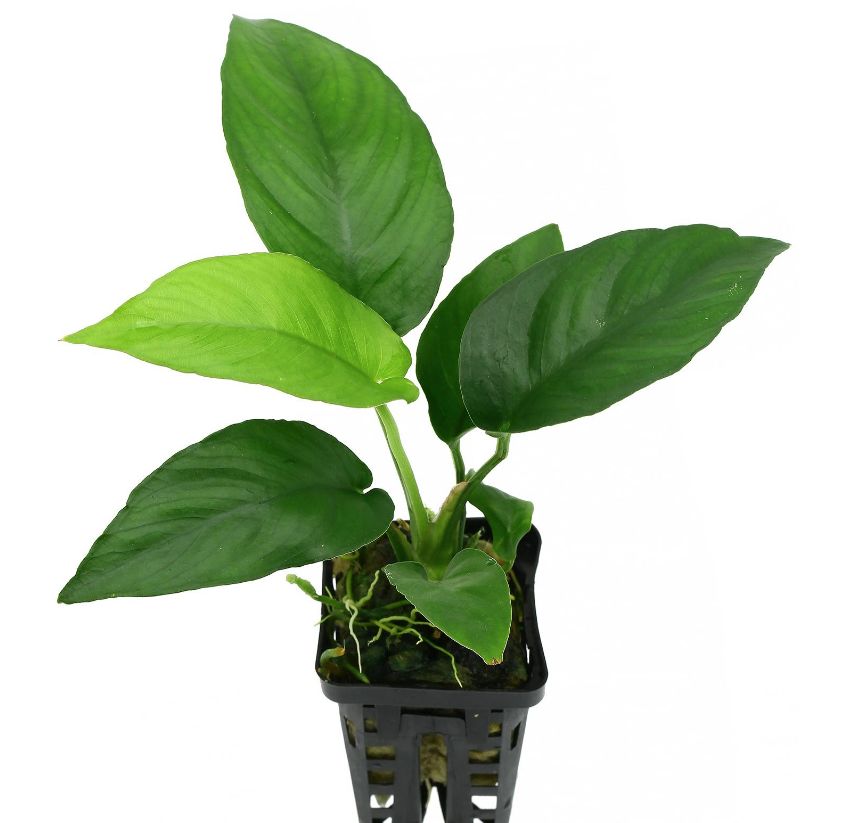
This Anubias species was received artificially. This is a hybrid obtained from intersection of Anubias barteri var. nana and Anubias gilletii. The breed got its name from combination of two words “nana” and “gi”. You can’t encounter this kind in the wild.
Its maximal size in a tank is about 15 cm, it has a heart shaped leaf with a short footstalk. As the plant grows it forms a small sized bush. It has a trailing rootstalk, that’s why you can plant it both in a substrate and on any proper surface (snags, stones etc.)
| Scientific Name | Anubias Nangi |
| Family | Araceae |
| Native To | Hybrid |
| Lighting Needs | Low to Moderate |
| Growth Form | Rhizome |
| Growth rate | Slow |
| Temperature Required | 72° – 80° F (22° – 27° C) |
| pH Level | 6.0-7.5 |
| Care Level | Easy |
| Placement in Tank | Foreground |
| Maximum plant size | up to 15 cm |